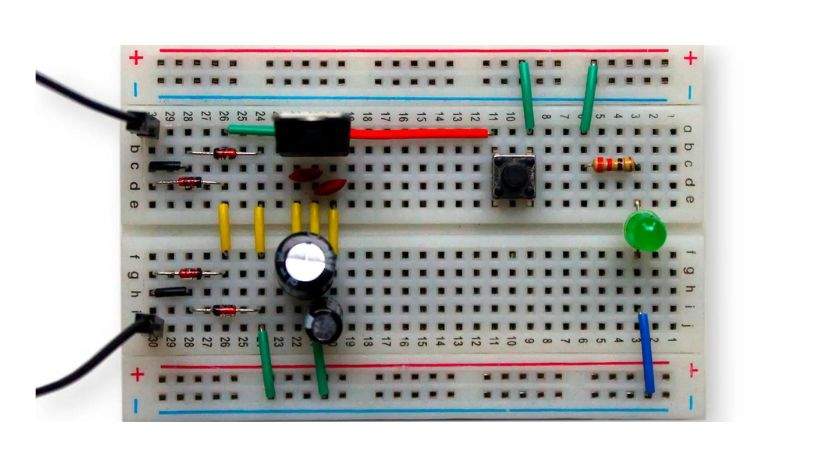Identifying diodes on a circuit board is a fundamental skill for electronic beginners, engineers, and enthusiasts.
The diode has a different physical appearance. By understanding diode symbols, recognizing different package types, deciphering markings, and codes, and using testing methods, you can confidently identify diodes on a circuit board. This knowledge not only enhances your understanding of circuit functionality but also enables efficient troubleshooting and repair.
In this article, we’ll talk about how can you identify diodes in a circuit board and will also do a fun activity to find diodes.
Identify diodes
Identifying diodes on a circuit board involves observing their physical characteristics, markings, and connections to other components.
Here is a step-by-step guide on identifying diodes in a circuit board.
1. Different types of diodes
There are different types of diodes. Understanding all these types is essential for identifying diodes in a circuit board.

These are just a few examples of the many types of diodes available, each with its unique characteristics and applications.
By understanding the physical appearance of these types you can easily identify the diode in a circuit.
1. Observe the physical characteristics
To identify diodes in a circuit board it is necessary to understand the physical characteristics of diodes. Diodes have different types and come in different package types, which can provide valuable clues for identification.
There are commonly two package types of diodes: Axial lead diodes and Surface mount diodes.
Axial lead
Axial lead diodes have wire leads emerging from each end and are often cylindrical. It consists of cathode and an anode terminals.

The body of the diode is cylindrical and has a band or stripe indicating the cathode side. The lead of these types of diodes is thicker and more rigid.
Radial lead
The radial lead diodes are a type of diode package that features leads emerging from the body of the diode in a radial pattern.

This package style is commonly used for through-hole diodes, which are diodes with leads that pass through holes in a circuit board and are soldered on the other side.
Radial lead diodes are often cylindrical or barrel-shaped, with leads spaced evenly around the circumference.
Surface mount diodes
Surface-mount technology is the method in which components are directly mounted on the circuit board.
Surface mount diodes are designed to be soldered directly onto the circuit board. They are typically rectangular or square-shaped and have a flat profile.

Surface mount diodes are much smaller than axial lead diodes and do not have wire leads. Instead, they have small metal pads on the bottom surface for soldering.
2. Read the Markings
Reading and understanding the marks or codes on the diode’s body can be quite helpful when trying to identify a diode on a circuit board.
These markings typically include alphanumeric codes, symbols, or labels that indicate the diode’s part number, manufacturer, characteristics, and specifications.
Begin by examining the diode for any visible markings. These markings are usually printed or etched onto the diode’s body. They can be located on the top, sides, or bottom, depending on the diode package type and manufacturer.
By carefully examining the circuit you can be able to identify the diodes in the circuit board.
3. Identify the diode polarity
Identifying diode polarity is crucial for finding diodes on a circuit board because diodes are polarized components, meaning they have a specific orientation for correct operation.
Diodes often have polarity markers such as “+” or “-” symbols printed on their bodies. These symbols indicate the cathode (negative terminal) and anode (positive terminal) of the diode.
Some diodes may have a colored band near the cathode or a notch on one end to indicate polarity.
This understanding not only helps in locating diodes on the board but also ensures proper circuit operation.
4. Analyze circuit connection
The location and connections of diodes to other parts of a circuit can be used to identify them. Rectification, voltage regulation, and protective circuits frequently use them.
- Rectifier diodes are frequently used in bridge arrangements, which consist of four diodes arranged in a square.
- Diodes can be connected in series with a load or series with an adjustable voltage reference in voltage regulators.
- Diodes for reverse polarity protection and voltage spike suppression may be found in protective circuits.
You can successfully identify diodes and understand their function within the circuit by looking at the circuit layout and identifying the unique characteristics of diodes.
Fun activity: Identify diodes in a circuit board
Up till now, you have enough knowledge about diodes and by using that information you can identify the diodes.
It will be fun to find diodes.
Let’s identify the diode in the circuit.

In the above circuit board, we have different components with axial and radial leads. The components with axial leads are two, the one is a resistor as the color bands are printed on it.
The other one is a diode as you see a gray band on the component as in the types of diode we have seen the physical appearance of the diode.
Let’s see another circuit and identify diodes.

Find the diodes and also tell how many diodes are connected in the circuit.
Let us know about your answer in the comment section.
Conclusion
For electronic enthusiasts and engineers, knowing how to identify diodes on a circuit board is an invaluable ability.
Diodes on a circuit board can be easily identified by comprehending diode symbols, identifying various package kinds, and decoding markings and codes.
This knowledge not only enhances your understanding of circuit functionality but also enables efficient troubleshooting and repair.
So, the next time you encounter a circuit board, take a closer look, identify those diodes, and unravel the mysteries they hold.
This was all about the diode identification, I hope you enjoy this article.
Thank you and stay blessed…
Happy diode identification!
Other useful posts:
